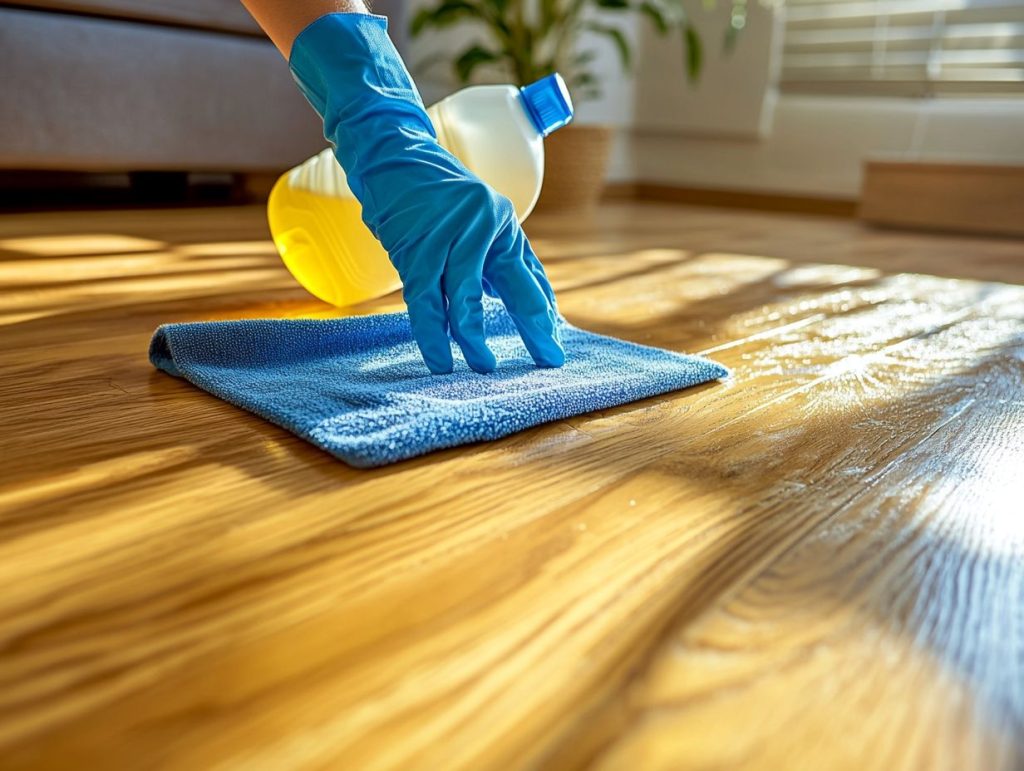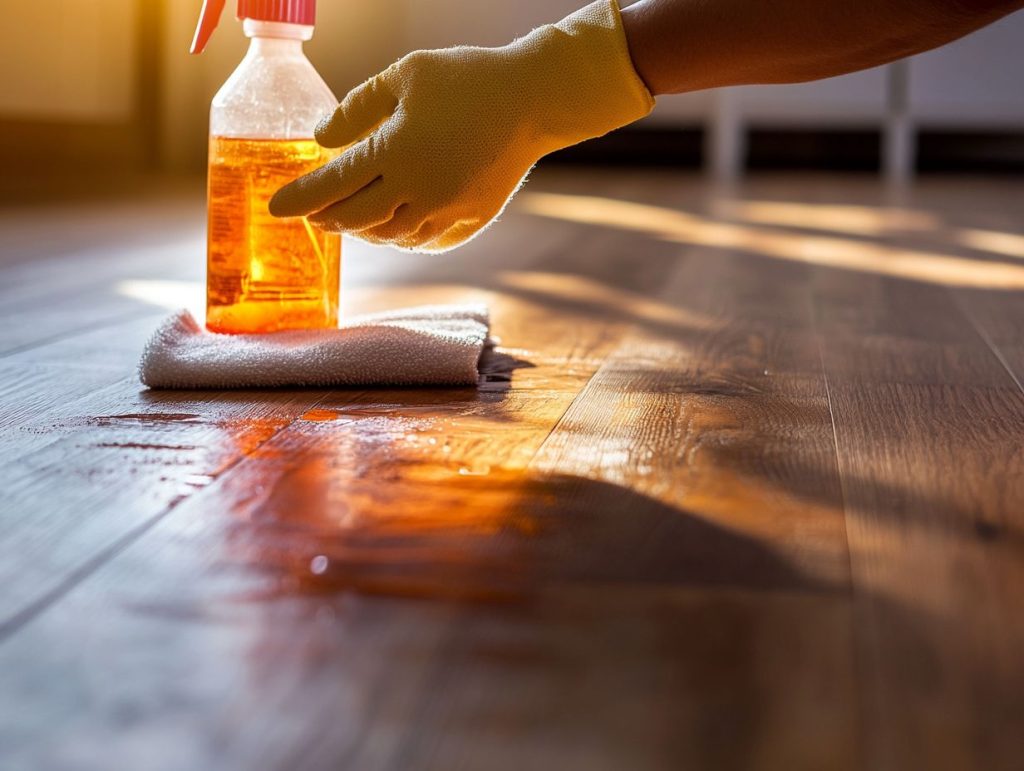How to Remove Sticky Residue from Hardwood Floors
Sticky residue on hardwood floors can be a frustrating issue for homeowners. Whether it’s from spilt food, cleaning products, or everyday wear and tear, this build-up detracts from the beauty of your floors and can lead to long-term damage.
This article explores the common causes of sticky residue, shares effective cleaning and maintenance strategies, discusses DIY methods and professional removal options, and provides tips on how to protect your hardwood floors once they’re restored.

Why Does Sticky Residue Appear on Hardwood Floors?
Understanding sticky residue on hardwood floors is critical to keeping them looking beautiful and lasting. This pesky residue can build up from various things, such as spilt adhesive, wax from floor polish, or even leftover cleaning solutions.
It’s essential to pinpoint the sources of that stickiness so you can tackle it effectively and prevent it from returning. By exploring some solid cleaning methods and strategies, you can achieve those pristine, residue-free floors while keeping the protective finish of your hardwood intact.
Common Causes of Residue Build-up
Several common causes contribute to that pesky residue build-up on your hardwood floors, such as sticky tape residue and adhesive stains from various household items. Wax build-up often sneaks in when you apply floor polish without giving the floors a good clean in between, leading to layers that can become a real headache to remove. Using the wrong cleaning supplies, whether natural cleaners or commercial products, can worsen the problem.
To tackle these issues effectively, it is essential to pinpoint the source of the residue and take preventive measures. For example, sticky tape often leaves an annoying residue that can be tricky to clean.
Instead of reaching for harsh chemicals, try a simple solution of warm water mixed with vinegar. It can help dissolve the glue without harming the finish of your floors. As for wax build-up, which usually comes from over-polishing, you can minimise it by thoroughly cleaning your floors with a pH-neutral cleaner before applying any polish.
Brands like Bona or Murphy’s Oil Soap are gentle yet effective for routine cleaning. Just steer clear of products labelled as ‘natural’ that contain oils or waxes, as they might leave their residue. Always check product labels for compatibility with hardwood surfaces to keep them looking beautiful and lasting longer.
Preventing Sticky Residue on Hardwood Floors
Preventing sticky residue on your wooden floors is key to keeping their natural shine and durability intact. Regular cleaning can prevent sticky substances from appearing, ensuring your wooden surfaces stay pristine.
Using effective cleaning tips and adhering to a proper maintenance checklist can help reduce the chances of residue build-up, allowing you to enjoy your beautiful floors without the hassle of sticky messes.
Effective Cleaning and Maintenance Strategies
Implementing effective cleaning and maintenance strategies is vital to keeping your hardwood floors looking their best and free from sticky residue. You have a range of cleaning methods at your disposal, from gentle cleansers to DIY cleaning solutions. By using the right tools and techniques, you can make the cleaning process easier and more effective.
For example, a vinegar solution of equal parts white vinegar and water can cut through grime without harming the wood finish. If you’re dealing with tougher stains, rubbing alcohol is a solid option. Just dilute it with water and apply it with a soft cloth for the best results. On the other hand, a mix of washing-up liquid and water is perfect for your daily cleaning needs.
Remember to use microfiber cloths to avoid scratching the surfaces, and apply gentle pressure while scrubbing. These methods not only clean but also help preserve the natural beauty of your wood floors, keeping them shining bright for longer.

Removing Sticky Residue from Hardwood Floors
To get rid of that sticky residue on your hardwood floors, you have some solid options—DIY methods and commercial products that do the job.
You can whip up a vinegar solution or grab some rubbing alcohol from your cleaning supplies; these household items work wonders on stubborn adhesive and sticky patches.
Make sure to choose the right cleaning agents, and your floors look clean and shiny, with no lingering residue or damage left behind.
DIY Methods and Products to Try
When dealing with sticky residue, plenty of DIY methods and products can do the trick while being eco-friendly. You can whip up some natural cleaners, such as a vinegar solution or plain old water, and use a sponge or soft bristle brush to gently scrub that adhesive away without harming your hardwood surface. Not only do these DIY solutions save you some money, but they’re also safe for your family’s health.
To tackle more challenging spots, mix the bicarbonate of soda with water to create a gentle, non-toxic abrasive paste. For those who like a bit of oil magic, a blend of coconut oil and bicarbonate of soda can help break down stubborn adhesive without any harsh chemicals.
Apply these mixtures and let them soak for a few minutes; that’ll loosen the residue nicely. By choosing these natural alternatives, you can achieve results similar to commercial adhesive removers while keeping your environmental footprint in check and ensuring your indoor air quality remains safe.
Professional Cleaning Options
If your DIY methods aren’t effective or you’re dealing with stubborn stains and residue that need extra care, it might be time to consider professional cleaning options.
Professional services are equipped with high-quality maintenance products and specialised tools, like a floor polisher, to thoroughly clean hardwood floors without causing damage.
It’s important to recognise when it’s best to call the professionals to keep your investment in your home’s hardwood surfaces safe and sound.
When to Call in the Experts
Knowing when to bring in the experts for a professional cleaning can save you time and ensure your hardwood floors receive the required care. It might be time to consult a professional if you’re dealing with tough stains, deep cleaning demands, or troublesome residue issues.
Regular check-ins can help you create a maintenance checklist that guides you on how often to clean based on your specific hardwood floor needs.
Understanding the wear patterns and environmental factors affecting your flooring can assist you in making those decisions. For instance, if you have high foot traffic or areas exposed to moisture, you might need to keep a closer eye on maintenance.
Incorporating seasonal evaluations into your routine can help you catch minor issues before they turn into costly repairs. By taking a proactive approach, you can preserve the longevity and beauty of your hardwood floors, ensuring they remain a stunning feature in your home for years to come.
When in doubt, reaching out for professional help is wise to protect your investment.
Protecting Hardwood Floors After Removing Residue
Once you’ve removed the sticky residue on your wooden floors, you should consider how to keep them looking great in the future. Applying a protective finish can help fend off spills and stains.
Furthermore, setting up a cleaning routine for your wooden surfaces will prevent that residue from returning. By preventing future build-up and treating your floors properly, you can enjoy your beautiful wooden floors for years.
Preventative Measures and Tips
Implementing preventative measures is your secret weapon for avoiding that pesky sticky residue on your hardwood floors. Simple cleaning tips, such as using the right cleaning supplies and creating a regular maintenance checklist, can work wonders for your wood floor care. By focusing on residue management and effective cleaning techniques, you can keep your floors pristine and maintain that shiny finish you adore.
To enhance your efforts, it’s essential to select cleaners specifically designed for hardwood. Those harsher chemicals can leave behind residues that will attract more dirt. Regularly sweeping or vacuuming helps eliminate debris that might lead to build-up, and adhering to a consistent mopping schedule means you’ll quickly tackle any spills or sticky spots.
Remember to place mats at your entryways to catch dirt and moisture before they interfere with your floors. With a little thoughtfulness in your cleaning routine and product choices, avoiding that annoying sticky residue becomes a doddle.